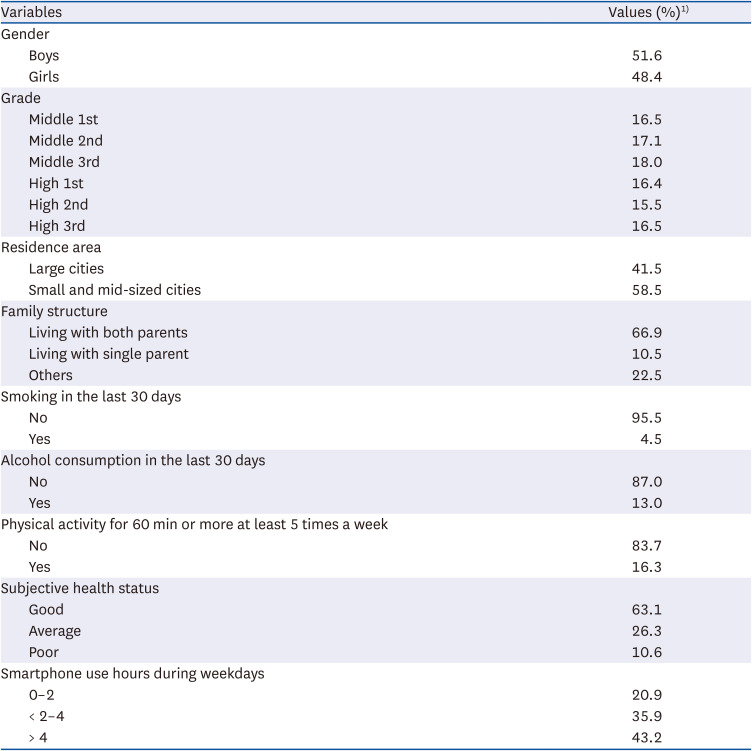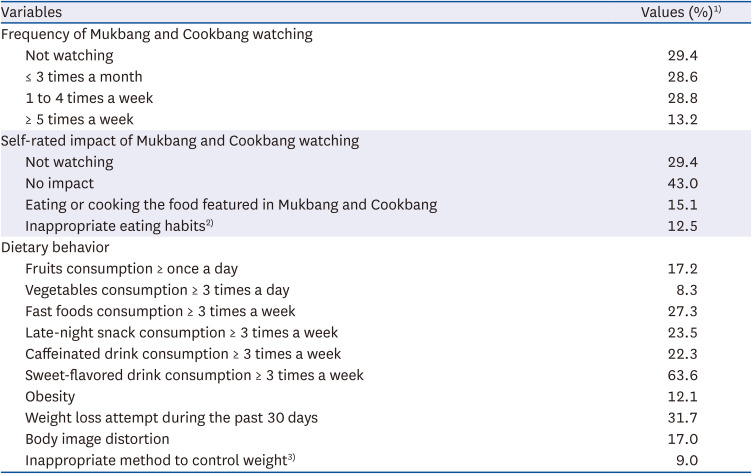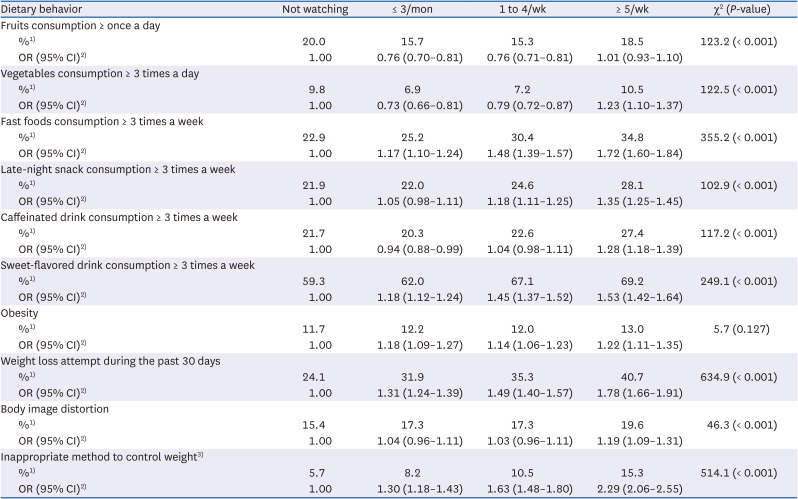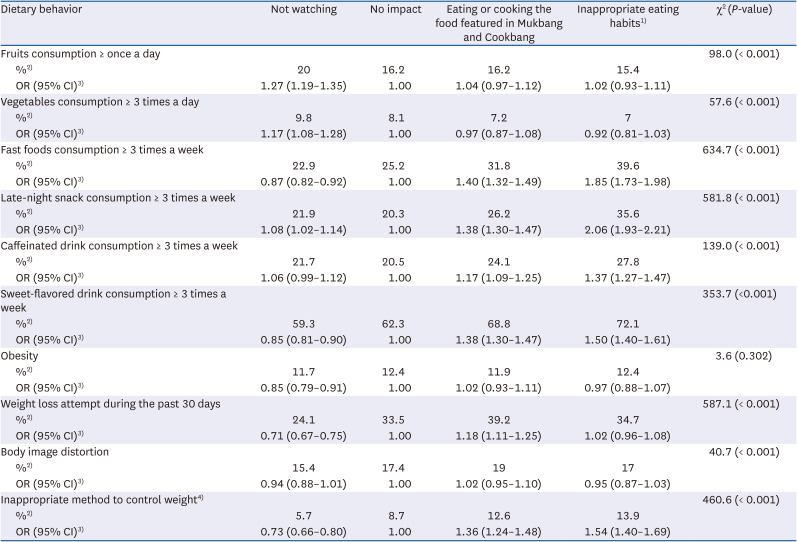INTRODUCTION
In 2019, Korea Broadcasting Advertising Corporation conducted a media and consumer research through a one-on-one individual interview survey targeting 4,000 men and women aged between 13 and 69 across the country. It revealed that Mukbang was the most commonly watched (28%) among online food-related videos [
1]. In another study of 380 Korean college students, 21.1% and 5.3% frequently watched; 43.9% and 27.9% moderately watched; and 35.0% and 66.8% did not watch Mukbang and Cookbang, respectively [
2]. Thus, Mukbang and Cookbang are widely consumed, mainly by the younger generation.
Over the last decade, Mukbang (eating broadcast) and Cookbang (cooking broadcast) have become popular online video content. Mukbang is an audiovisual broadcast in which the creator or the host eats alone or in groups, and communicates with viewers while eating. Cookbang introduces recipes or presents cooking processes through content showing hosts preparing or cooking their ingredients [
2]. As many Cookbang videos show the host eating after cooking, they are viewed as an extension of Mukbang. Traditionally, food-related broadcasts presented scenes of eating or cooking. However, the major advantage leading to the immense popularity of Mukbang and Cookbang is its ability to enable viewers to communicate and enjoy their food with others in real time. These livestream eating broadcasts are also popular in overseas countries.
The popularity of Mukbang and Cookbang may be primarily owing to an increase in the number of people eating alone or experiencing loneliness [
3]. Viewers often watch these videos while eating alone, which gives them vicarious satisfaction [
4]. A study examining consumers’ attitudes toward Mukbang through online self-report questionnaires found that Asians tended to watch them because of the host’s attractiveness and social normative influence of the videos, while Caucasians watched them because of the host’s attractiveness and the perceived novelty, and social normative influence of the videos [
5]. Video creators intentionally make loud sound while eat or place food close to the camera to maximize viewer satisfaction. Through these visual and auditory stimuli, Mukbang viewers feel that their craving for food is satisfied vicariously. Consequently, Cookbang has gained popularity with famous chefs as well as with those living alone as it provides useful cooking tips.
The increasing popularity of Mukbang and Cookbang has resulted in the growth of interest in their potential health benefits. In a study of Korean college students, 29.1% responded that eating out or consuming home delivered, and convenience store food increased because of Mukbang, which was higher in those who watched it frequently (42.5%) than in those who watched it moderately (22.8%). In addition, 41.3% responded that their cooking frequency increased while 14.3% responded that their eating habits were positively affected by watching Cookbang [
2]. A qualitative analysis of YouTube comments and Reddit posts on Mukbang and eating disorders reported that online users engage with Mukbang not only as viewers, but also as participants, describing their experiences of reactions and behaviors toward watching. Thus, Mukbang can be both helpful and destructive as it can limit and increase eating, reduce loneliness and guilt, and become self-destructive [
6].
Adolescents, in particular, can be influenced by popular broadcasts because they are easily influenced by and tend to follow trendy or famous people [
78]. Accordingly, there are concerns about the potential health effects of watching Mukbang and Cookbang in adolescents, but data are limited. This study aimed to determine the status of watching Mukbang and Cookbang among Korean adolescents and its relationship with dietary behavior.
SUBJECTS AND METHODS
Data source and study population
This study used data from the 18th Korea Youth Risk Behavior Survey (KYRBS), conducted in 2022. The survey has been conducted annually since 2005 to understand the health behaviors of adolescents in Korea. The survey targeted students enrolled in middle and high schools nationwide, as of April 2022. Region and school levels were used as stratification variables and 800 schools (400 middle schools, and 400 high schools) were selected. Schools were selected using a proportional sampling method to match the study population. The study employed stratified cluster sampling with schools as the primary sampling units and classes as the secondary units [
9]. The KYRBS protocol was approved by the Institutional Review Board of the Korea Centers for Disease Control and Prevention (2014-06EXP-02-P-A), and informed consent was obtained from all participants. Data were collected via online self-administration. This study analyzed 51,850 adolescents who participated in the 2022 survey.
General characteristics
General characteristics included gender (boys, girls), grade (middle school 1–3, high school 1–3), residence area (large, small and mid-sized cities), family structure (living with both parents, with single parent or others), smoking in the last 30 days (no, yes), alcohol consumption in the last 30 days (no, yes), physical activity for 60 min or more at least five times a week (no, yes), subjective health status (good, average, poor), and smartphone use hours during weekdays (0–2, < 2–4, > 4 h).
Mukbang and Cookbang watching
The study included the frequency of watching Mukbang and Cookbang and their self-rated impact. The frequency of watching was categorized as not watching, less than 3 times a month, 1 to 4 times a week, and 5 or more times a week using the following question: “Over the past 12 mon, how often have you watched Mukbang (eating broadcasts) and Cookbang (cooking broadcasts)?” The self-rated impact of watching was categorized as not watching, no impact, eating or cooking the food featured in Mukbang or Cookbang, and inappropriate eating habits (eating quickly, eating a lot, eating stimulating food such as spicy, salty, or sweet food, eating snacks or late-night snacks other than meals) using the following question: “What is the biggest impact of watching Mukbang (eating broadcasts) and Cookbang (cooking broadcasts) on your eating habits?”
Dietary behavior
Dietary behavior were defined using KYRBS health indicators which included fruits consumed once or more per day, vegetables consumed 3 or more times a day, fast food consumption 3 or more times a week, late-night snack consumption 3 or more times a week, caffeinated drink consumption 3 or more times a week, sweet-flavored drink consumption 3 or more times a week, obesity, weight loss attempts during the past 30 days, body image distortion, and inappropriate methods to control weight. Obesity was defined as a body mass index (BMI) above the 95th percentile for age and sex according to the 2017 Korean National Growth Chart for Children and Adolescents. The BMI (kg/m2) was calculated using self-reported height and weight. The distorted body image perception was defined as a BMI below the 85th percentile and a response of “I am a bit fat” or “I am very fat” to the following question: “What do you think your body type is?” Weight loss attempt during the past 30 days was defined as the response “Have tried to lose weight in the last 30 days” to the question “In the last 30 days, have you tried to control your weight?” An inappropriate method to control weight was defined as attempting one or more of the following in the past 30 days: fasting for more than 24 h, taking weight-control medication without a doctor's prescription, vomiting or taking laxatives after eating, and engaging in a one-food diet.
Analysis
Data were analyzed using SAS 9.4 software. Adolescent characteristics were presented using frequency analysis, showing frequencies and percentages. Chi-square tests were used to compare dietary behaviors according to the frequency and impact of watching Mukbang and Cookbang. Multiple logistic regression analysis was conducted to derive adjusted odds ratios (aOR) and 95% confidence intervals (CI) to understand the relationship between watching Mukbang or Cookbang and dietary behavior after controlling for covariates known to be related to dietary behavior of adolescents in previous studies [
101112]. We then conducted subgroup analyses according to gender and school level. All analyses reflected the multi-stage cluster sample design of the KYRBS and appropriate sampling weights using the PROC SURVEY procedure. The statistical significance level was set at
P < 0.05.
DISCUSSION
The frequency of watching Mukbang and Cookbang among Korean adolescents was as follows: 29.4% did not watch, 28.6% watched 3 times a month, 28.8% watched 1 to 4 times a week, and 13.2% watched more than 5 times a week. The self-rated impact of watching Mukbang and Cookbang was as follows: 43.0% watched but were not influenced, 15.1% ate or cooked food featured in Mukbang and Cookbang, and 12.5% developed inappropriate eating habits. Dietary behavior according to the frequency of viewing revealed that adolescents who watched frequently were more likely to consume fast food, eat late-night snacks, and consume sugary beverages. Depending on the self-rated impact of watching, those who responded that their dietary habits were influenced by watching Mukbang and Cookbang were more likely to consume fast food, late-night snacks, caffeinated beverages, and sugared beverages and were less likely to consume fruits and vegetables.
In our study, 71.5% of Korean adolescents had watched Mukbang and Cookbang in the past 12 mon, and 44.8% had watched them more than once a week. In a study of Korean adolescents aged 15 yrs or older who watched Mukbang or Cookbang, more than half of the participants watched them at least once a week [
13]. In another study of Korean adolescents who watched food-related content over the past year, Mukbang was the most watched content (50.0%), followed by Cookbang (30.1%). YouTube was the most popular content-viewing channel (80.8%), with an average daily viewing time of 47.3 min [
14]. With the popularization of smartphones and the growth of food-related videos through various easily accessible media, such as YouTube, the views of Mukbang and Cookbang is expected to increase in the future.
As the frequency of watching Mukbang increased, obesity and the consumption of fast food, sweetened drinks, late-night snacks, and body image distortion increased. Vegetable and fruit consumption was lower in those who watched Mukbang less than 3 times a month and those who watched one to four times a week than in those who did not watch Mukbang. This finding is similar to that of previous studies. Adolescents who used a lot of food-related content often replaced meals with convenience store food or instant food and frequently ate late-night snacks [
15]. In a study conducted on adults who watched Mukbang, those who spent a lot of time watching it preferred foods rich in carbohydrates and meat, frequently used food-delivery services and late-night snacking, and perceived their body image as obese. Conversely, people who spend less time watching Mukbang per week preferred vegetables and fruit [
16].
In this study, the majority of the participants responded that watching Mukbang or Cookbang had no impact on their eating habits, whereas 15.1% responded that they ate or cooked food from Mukbang or Cookbang. However, 7.7% said that they engaged in inappropriate eating habits owing to watching broadcasts that featured eating quickly or eating a lot. In a study of adults who watched YouTube’s Mukbang channels within the past 3 mon, 80% responded that they had purchased food introduced in the video [
17]. A study reported that Mukbang influenced the intention to purchase food that appeared in a video through entertainment, information, and vicarious satisfaction [
18]. These results suggest that watching Mukbang or Cookbang influences food choices and dietary behavior.
Although people have been watching Mukbang and Cookbang for over a decade, little is known about their potential health effects. Our study found that adolescents who watched Mukbangs frequently or used it inappropriately were associated with undesirable eating behaviors. This suggests that nutritional education and content would be needed to improve adolescents' eating habits, especially for girls and lower-grade adolescents who watch the broadcast frequently and are greatly influenced by the broadcast. Nutrition education on the awareness and importance of proper eating habits for Mukbang viewers could be suggested. And, given the popularity of Mukbang and Cookbang and the increasing use of videos among adolescents, there may be a need to create content that includes wise broadcast selection, food choices and eating habits related to dietary behavior and health promotion. This will stimulate interest in adolescents and maximize educational effectiveness.
As personal broadcasting platforms have become more accessible, Mukbang and Cookbang are becoming popular resulting in growing concerns about their potential health effects. Given the prevalence and spread of Mukbang and Cookbang, it is timely to evaluate their potential health effects. This study presents the latest evidence on the current status of Mukbang and Cookbang and their health impacts. This study could not investigate the types of food (fast food, alcohol, etc.) or the type or content (cooking food, overeating, eating quickly, eating spicy food, etc.) covered in the broadcasts. Therefore, we suggest that future studies should examine the content of broadcasts to comprehensively understand the impact of Mukbang and Cookbang on dietary habits in Korean adolescents.
Studies have reported that individuals primarily watch Mukbang not only to relieve stress but also because they contribute in controlling appetite and conveying food-related information [
19]. Viewers not only enjoy eating but they also want to acquire useful information regarding food such as nutritional information and hygiene-related knowledge during cooking [
20]. Mukbang has a positive aspect, in that it can bring a sense of happiness or satisfaction. Viewers gain a sense of belonging by communicating with the Mukbang host. Moreover, it has entertainment elements that help relieve stress in daily life [
1721]. Therefore, future research should consider both the benefits and harmful effects of watching Mukbang or Cookbang.
This study conducted a comprehensive analysis of watching Mukbang and Cookbang, and dietary behavior using nationwide data from adolescents. To the best of our knowledge, this is the first study to investigate the frequency of watching Mukbang or Cookbang among Korean adolescents using representative data as well as the self-rated impact on their dietary behavior. Our study examined the status of watching Mukbang or Cookbang and evaluated their influence on adolescents’ dietary behaviors.
This study has several limitations. First, using the KYRBS, a cross-sectional survey, we investigated the relationship between watching Mukbang and Cookbang and dietary behavior; however, we could not determine the temporal relationship. Therefore, watching Mukbang or Cookbang may have had a negative effect on eating habits; conversely, those with poor eating habits may have frequently watched Mukbang or Cookbang. Second, because the data were collected using a self-administered survey, height and weight may differ from body measurements [
22], and health behaviors, such as smoking or drinking, may have been responded to in a socially desirable direction. Finally, although we investigated the frequency of watching Mukbang or Cookbang and their self-rated impact, we could not include broadcasts such as the types of food (e.g., fast food, instant food, alcohol), amount of food, and types of Mukbang (e.g., cooking food, overeating, eating quickly, and eating spicy food). A study on YouTube’s Mukbang content found that provocative content was related to video popularity [
3]. Therefore, future studies should examine the content of Mukbang and Cookbang, to improve our understanding of the health effects of watching them.
This study aimed to clarify the impact of watching Mukbang and Cookbang on the dietary behavior of Korean adolescents using nationally representative data. Among all adolescents, 71.5% watched Mukbang and Cookbang, with 13.5% watching more than five times a week. The self-rated impact of Mukbang and Cookbang was that 15.1% ate or cooked the foods featured in the videos and 7.7% developed inappropriate eating habits. Adolescents who watched frequently or were influenced by watching were more likely to consume fast food, late-night snacks, and sugary beverages, and were more likely to attempt weight loss and use inappropriate weight loss methods. These results suggest that watching Mukbang and Cookbang negatively affects food choices and dietary habits. Nutritional education that emphasizes the importance of watching videos wisely in relation to good eating habits may be considered. And, considering the increase and spread of Mukbang and Cookbang among adolescents, it may be necessary to produce content that includes food selection, meals, and eating habits related to proper dietary behavior and health promotion. Future studies should investigate the content aspects of broadcasts and include the positive effects of Mukbang and Cookbang, such as stress relief, appetite control, and food-related information. Considering that the trend of watching Mukbang or Cookbang is a long-term phenomenon, longitudinal studies on its health effects are required.








 PDF
PDF Citation
Citation Print
Print



 XML Download
XML Download